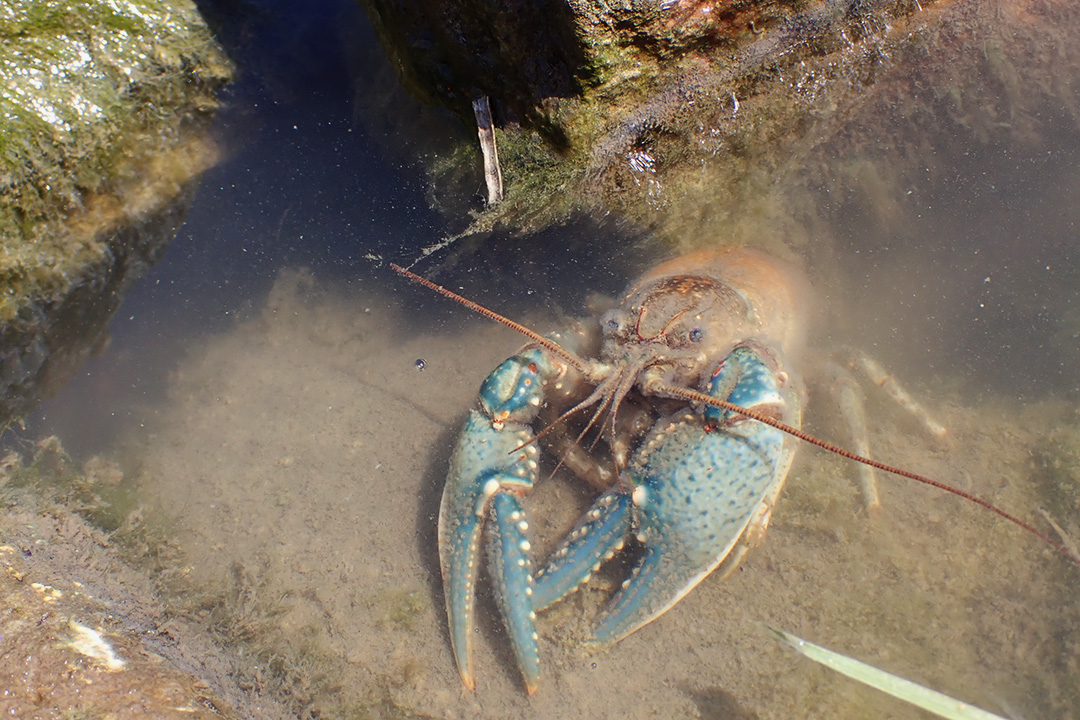
USask scientists explore tiny crayfish’s big impact on environment and other animals
Adult crayfish are about 10 centimetres in size, but despite their tiny stature, these freshwater crustaceans can cause big changes in the environment that affect other animals.
By Shanae HeuerCrayfish are known as “ecosystem engineers” that move around stones, plants and other objects in their environment. As a result, their actions change the availability of these resources for other animals that use them.
Another ecosystem engineer is the beaver — they earned this title by cutting down trees and building dams. Just like the crayfish, beavers’ engineering activities will have an impact on other animals. For example, dams created by beavers increase the number of shelters available for many different types of animals.
Some beneficial changes that crayfish make are from moving gravel. Using their claws like excavators, they lift pieces of gravel and modify the bottom of freshwater rivers and lakes. Crayfish have been shown to increase the amount of sand compared to gravel, which helps to increase the chance of survival for the eggs of trout and other fish species.
Crayfish also break down leaves and other decaying plants so the organisms’ nutrients can be used again by other plants and animals.
These examples make crayfish sound incredibly helpful and beneficial — but they can also cause negative impacts in areas to which they’re introduced.
Crayfish can be released into new areas when fishermen use them as live bait and the crustaceans escape their fate of becoming fish food. In other cases, birds can carry and drop crayfish into new regions. All these actions are helping to expand the habitat of crayfish, providing them with new environments to explore and move. Understanding their impacts on these new environments will help researchers know how to prevent potentially damaging consequences.
These new environments often have different structures or water qualities than what crayfish are used to, and these changes can have an impact on how crayfish interact with their environment.
For example, crayfish like to snip plants for something to eat or so they can hunt for their food more easily. In turn, this destructive behaviour can harm snails that rely on the local plants to eat and live on. When crayfish are introduced to an environment, it often results in snails not having a good habitat to survive in. Even in small numbers, crayfish have been found to wipe out snail populations.
As well, crayfish will eat just about anything they can catch — including fish eggs, which can have a negative impact on fish populations. These actions can also have a domino effect: when crayfish eat so much of one fish species, then the prey of that species may become overpopulated and cause other negative effects.
As researchers learn more about crayfish behaviour, new factors often arise that can change it. Human influences, such as the addition of plastics or pollutants, will also alter their environments.
A common toxin that enters water streams is nitrate, which can be washed into waterways from nitrogen-based fertilizers used on agricultural crops. Previous research shows that when crayfish are exposed to high amounts of nitrate, they move less, show decreased aggressiveness and eat less.
But how does nitrate affect other beneficial actions of crayfish? That’s where we need more research studies to learn more about the implications. For example, if added nitrate causes crayfish to move less, it may affect how much gravel they move on the bottom of rivers and streams. This behaviour would then affect fish populations that depend on crayfish-engineered gravel piles to protect their eggs.
For such small creatures, crayfish are still important to study due to their large impact on other animals in rivers and lakes. Researchers also view crayfish as a good species to monitor when we want to gauge the quality of an environment since crayfish will change how they behave when pollution or other changes in the aquatic environment occur.
The next time you see one of these little snappy creatures, think about all the work they do and their impact on their environment — then think about how our actions might affect crayfish and the other animals and plants with which they interact.
Shanae Heuer of Perth, Western Australia, is a University of Saskatchewan (USask) master’s student based at the Western College of Veterinary Medicine (WCVM). She studies the effect of different environments on the ecosystem engineering of crayfish. Her graduate supervisor is Dr. Maud Ferrari, a professor in the WCVM’s Department of Veterinary Biomedical Sciences